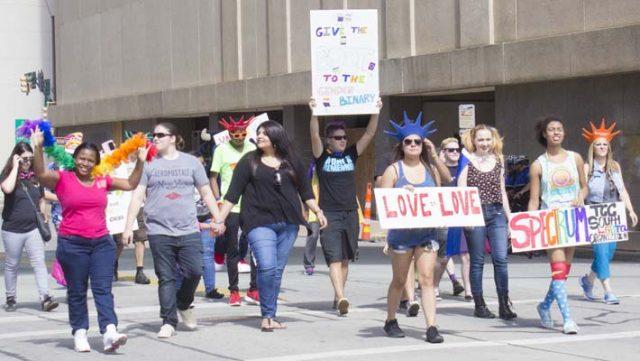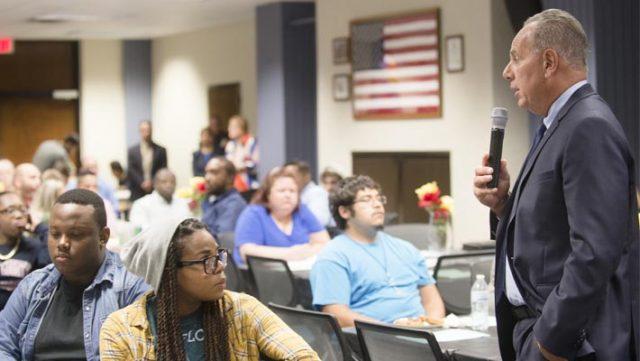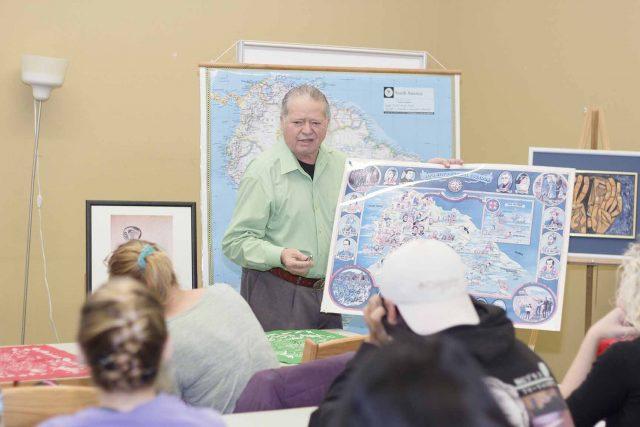By Sheri-Lee Norris/ campus editor
NE students learned tricks, tips and tools Sept. 26 at Get Back on Track and Finish the Race: Achieving College Success.
Pizza, PowerPoint, group activities and flying squishy balls were all part of the interactive learning experience. This information-packed seminar used various methods to demonstrate how students learn differently and should study in ways that help them best. They also discovered where to find both help and fun at NE.
“This is my favorite workshop,” special services coordinator Ronda Isaacs said. “It’s a fun program, and it’s great to see the lights go on for students.”
At the end of the evening, she tossed squishy balls to students who accurately answered questions. The balls are considered a tool for a certain type of learner, the students had discovered.
Student accessibility resources coordinator Kim Eason explained how to calculate GPA and why it is important to protect it. Students who fall below a C average of 2.0 face academic suspension, she said.
Academic advisor Carey Miller discussed the pros and cons of utilizing credit recovery.
“The fastest way to restore your GPA is by taking a class over,” she said.
She emphasized, however, that it’s best to talk to a counselor first.
If students plan to transfer to four-year universities, they need to know the importance of a GPA, transfer center coordinator Vanessa Ximenez said. She cautioned against aiming for C’s.
“You may be accepted at a university with a 2.25 GPA,” she said. “However, you may not get accepted into any programs as most require at least a 3.0 GPA. Many in the sciences demand 3.5 GPA or higher.”
Ximenez said the transfer office can help identify which schools offer desired programs, assist with completing applications and show ways to search for scholarships.
Students completed learning style evaluations to discover whether they were visual, auditory or kinesthetic learners. Some were a combination.
“Knowing how you learn is critical to knowing how to study,” Eason said.
Miller, a self-identified kinesthetic, said she learns best while doing other things at the same time.
“Record the lesson or download a book on tape,” she said. “If you are a kinesthetic learner, don’t sit down and read ― plug in the earphones and go out for a walk. We learn best while moving and doing. If you are forced to sit in a classroom, play with a squishy ball or chew gum to help focus.”
Eason is a visual learner. She likes reading books and using colored markers. She showed the group her lecture materials with portions highlighted in pink.
“I love color and order,” she said. “The markers are my tools.”
Auditory learners do best by hearing things more than once, Eason said. Recording a lesson and playing it back is helpful. They also do well in small groups and reading books out loud.
Counselor Masika Smith summarized how the seemingly unrelated discussions all fit together by use of an analogy: a large puzzle. She asked how many in the room liked jigsaw puzzles. Most didn’t like them and agreed they were frustrating. However, one student said they were easy if you put the edges together first.
“Exactly!” exclaimed Smith. “You have a strategy. We are here to give you all strategies to complete what you started. First, you understand yourselves a little better now, right? Next, you learn what resources we have to help. That’s how you put it all together to finish this race we call college.”
The workshop will be repeated noon-2:30 p.m. Oct. 12, 5:30-8 p.m. Oct. 27, noon-2:30 p.m. Nov. 2 and 5:30-8 p.m. Dec. 1 in the Community Room (NBSS 1103).





























